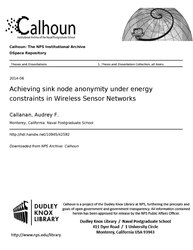File:Achieving sink node anonymity under energy constraints in Wireless Sensor Networks (IA achievingsinknod1094542592).pdf

Original file (1,275 × 1,650 pixels, file size: 1.41 MB, MIME type: application/pdf, 150 pages)
Captions
Captions
Summary[edit]
| Achieving sink node anonymity under energy constraints in Wireless Sensor Networks
( |
||
|---|---|---|
| Author |
Callanan, Audrey F. |
|
| Title |
Achieving sink node anonymity under energy constraints in Wireless Sensor Networks |
|
| Publisher |
Monterey, California: Naval Postgraduate School |
|
| Description |
A wireless sensor network (WSN) is a distributed network that facilitates wireless information gathering within a region of interest. For this reason, WSNs are relied upon by the Department of Defense for deployment in remote and hostile areas. The information collected by sensors is aggregated at a central point known as a sink node. Two challenges in the deployment of WSNs are limited battery power of each sensor node and sink node privacy/anonymity. The role played by the sink node raises its profile as a high value target for attack, thus its anonymity is crucial to the security of a WSN. In order to improve network security, we must implement a protocol that conceals the sink node’s location while being cognizant of energy resource constraints. In this thesis, we develop a routing algorithm based on node clustering to improve sink node anonymity while simultaneously limiting node energy depletion. Via MATLAB simulations, we analyze the effectiveness of this algorithm in obfuscating the sink node’s location in the WSN while preserving node energy. We show that the anonymity of the sink node is independent of traffic volume and that the average energy consumed by a node remains consistent across topological variations. Subjects: Wireless Sensor Networks; WSN; Ad Hoc Network; ground sensor network; Cluster routing; Sink Node Anonymity; Base Station Anonymity; Location Privacy |
|
| Language | English | |
| Publication date | June 2014 | |
| Current location |
IA Collections: navalpostgraduateschoollibrary; fedlink |
|
| Accession number |
achievingsinknod1094542592 |
|
| Source | ||
| Permission (Reusing this file) |
This publication is a work of the U.S. Government as defined in Title 17, United States Code, Section 101. As such, it is in the public domain, and under the provisions of Title 17, United States Code, Section 105, may not be copyrighted. | |
Licensing[edit]
| Public domainPublic domainfalsefalse |
This work is in the public domain in the United States because it is a work prepared by an officer or employee of the United States Government as part of that person’s official duties under the terms of Title 17, Chapter 1, Section 105 of the US Code.
Note: This only applies to original works of the Federal Government and not to the work of any individual U.S. state, territory, commonwealth, county, municipality, or any other subdivision. This template also does not apply to postage stamp designs published by the United States Postal Service since 1978. (See § 313.6(C)(1) of Compendium of U.S. Copyright Office Practices). It also does not apply to certain US coins; see The US Mint Terms of Use.
|
 | |
| This file has been identified as being free of known restrictions under copyright law, including all related and neighboring rights. | ||
https://creativecommons.org/publicdomain/mark/1.0/PDMCreative Commons Public Domain Mark 1.0falsefalse
File history
Click on a date/time to view the file as it appeared at that time.
| Date/Time | Thumbnail | Dimensions | User | Comment | |
|---|---|---|---|---|---|
| current | 20:54, 13 July 2020 |  | 1,275 × 1,650, 150 pages (1.41 MB) | Fæ (talk | contribs) | FEDLINK - United States Federal Collection achievingsinknod1094542592 (User talk:Fæ/IA books#Fork8) (batch 1993-2020 #5134) |
You cannot overwrite this file.
File usage on Commons
The following page uses this file:
Metadata
This file contains additional information such as Exif metadata which may have been added by the digital camera, scanner, or software program used to create or digitize it. If the file has been modified from its original state, some details such as the timestamp may not fully reflect those of the original file. The timestamp is only as accurate as the clock in the camera, and it may be completely wrong.
| Short title | Achieving sink node anonymity under energy constraints in Wireless Sensor Networks |
|---|---|
| Author | Callanan, Audrey F. |
| Software used | Callanan, Audrey F. |
| Conversion program | Microsoft® Word 2010 |
| Encrypted | no |
| Page size | 612 x 792 pts (letter) |
| Version of PDF format | 1.4 |

